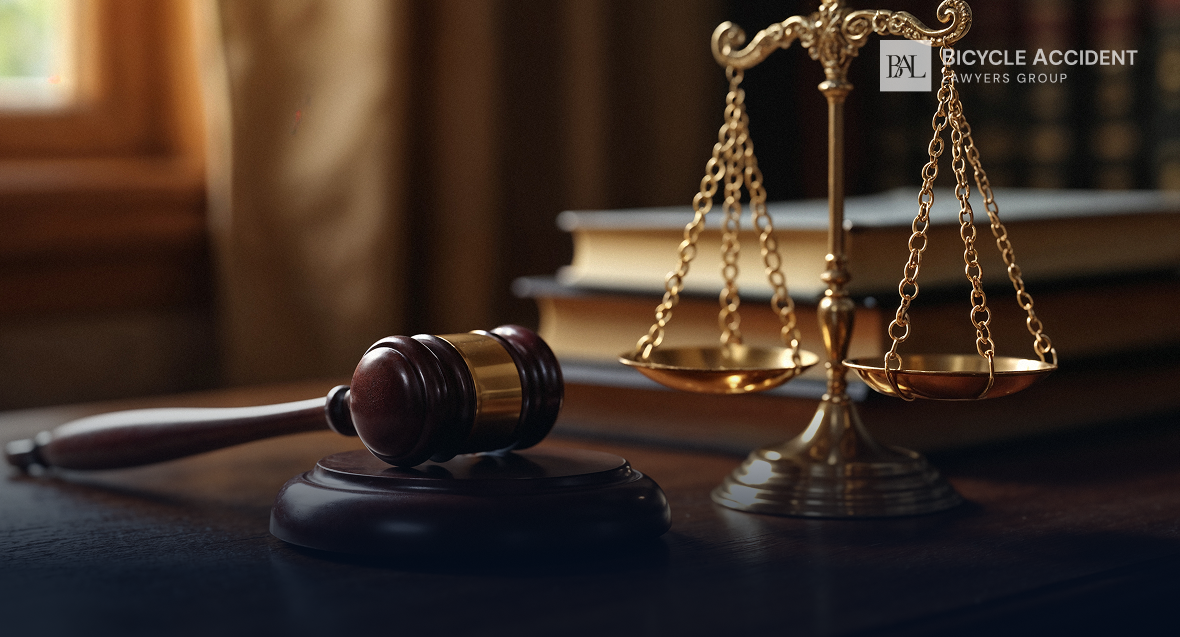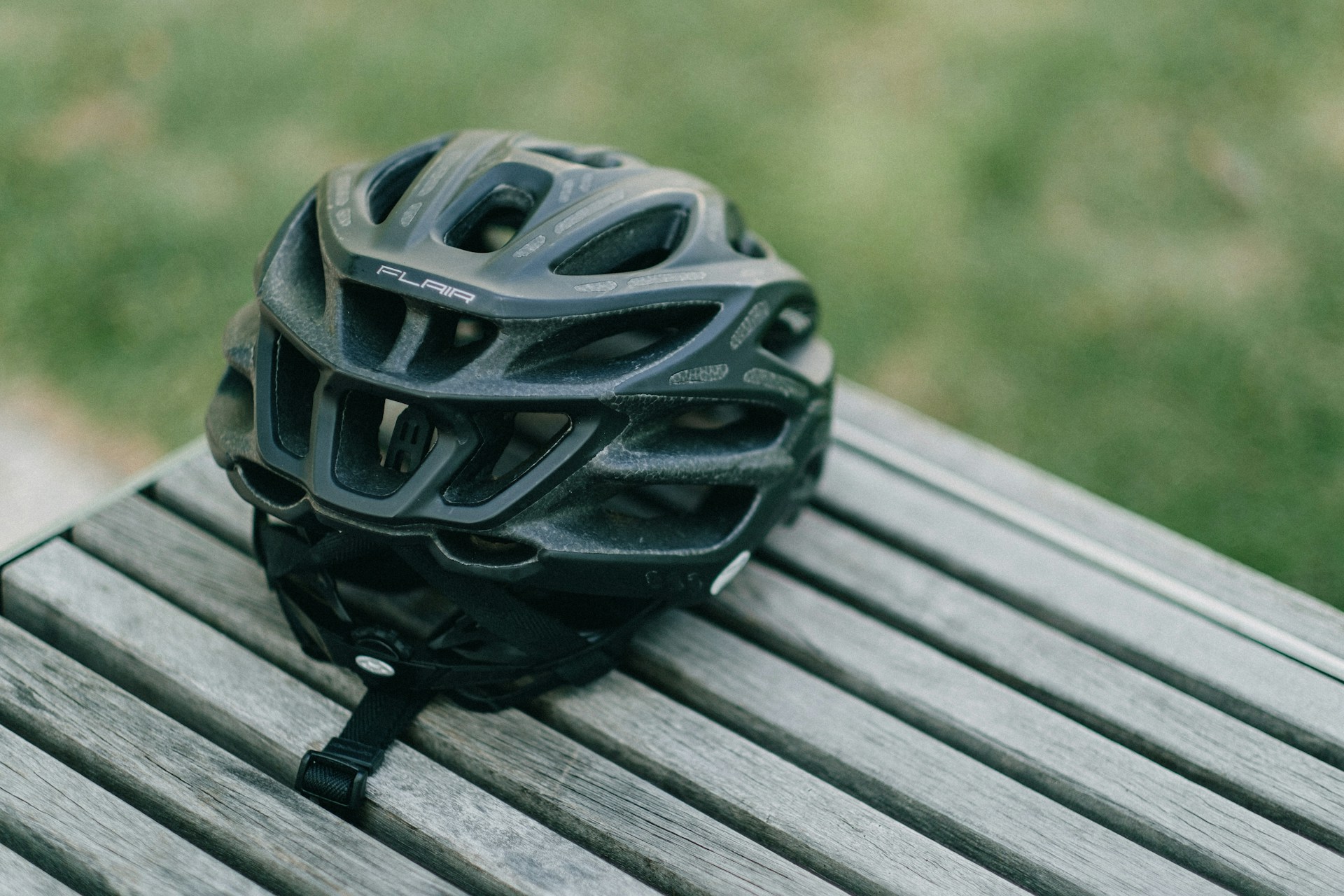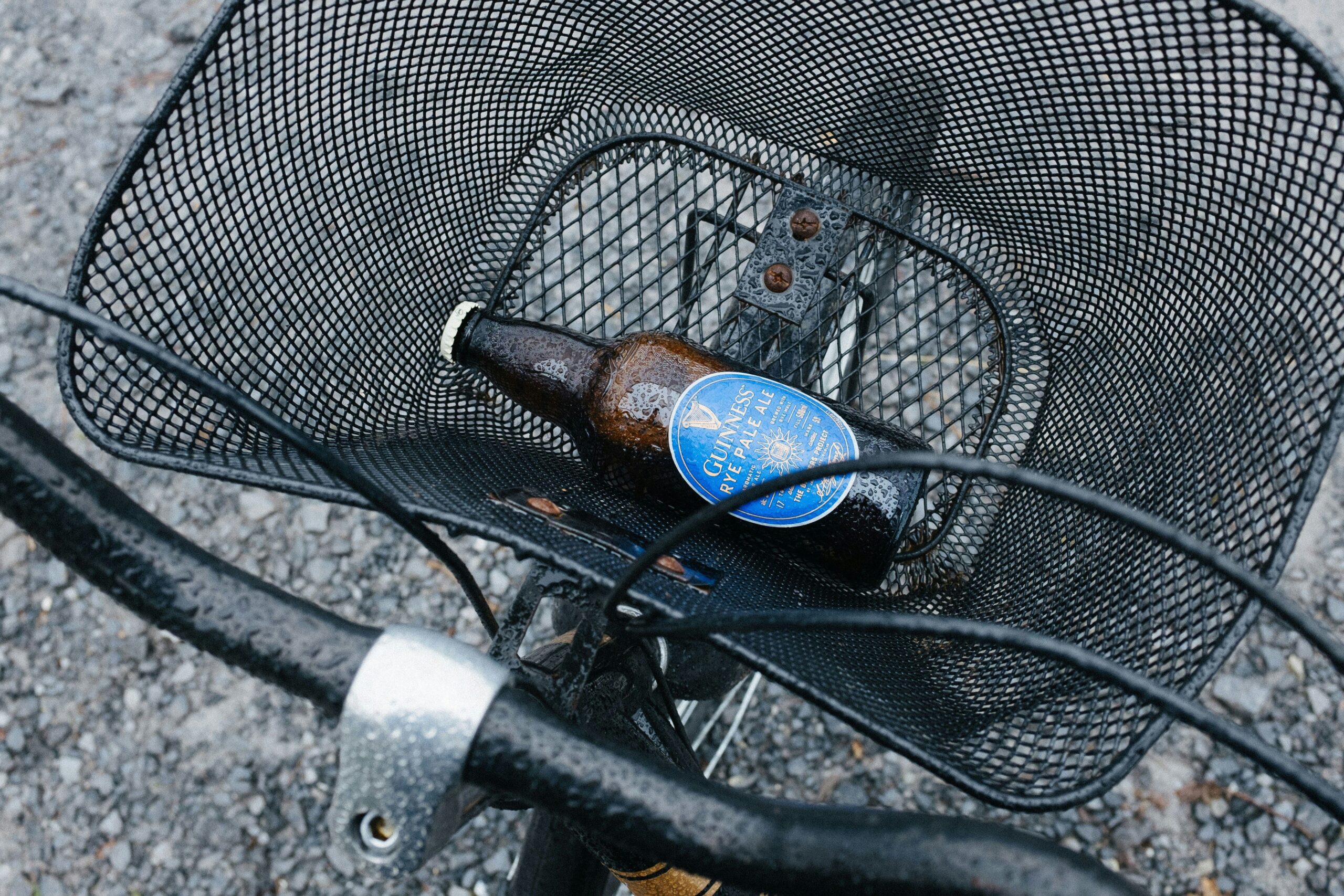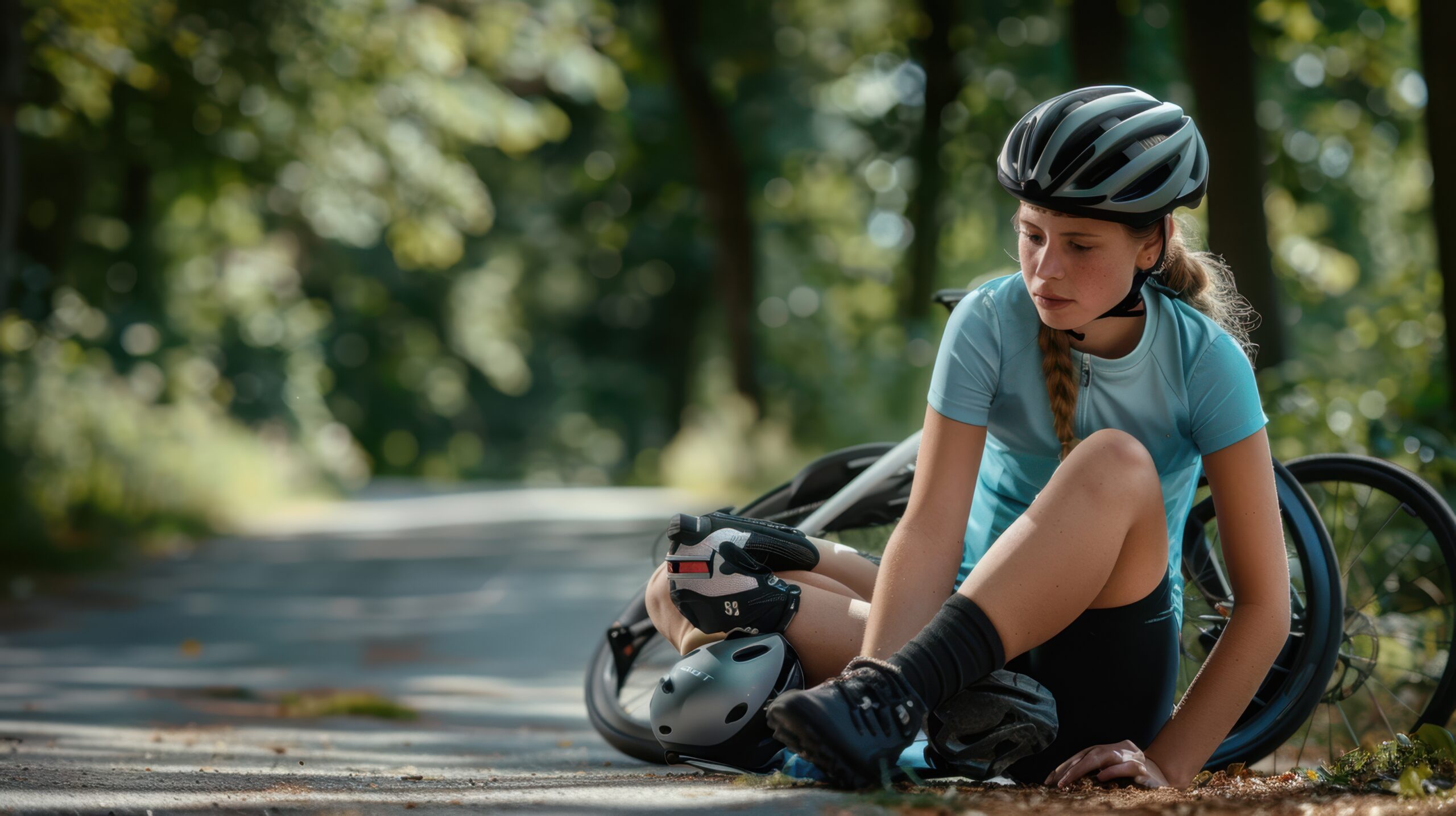Most people operating a bicycle in the Peach State view it as a pleasant and healthy pedal-and-go activity, which it certainly is. However, a split second can turn your world upside down. Recent Georgia bicycle accident statistics show that there were over 900 varying-scale incidents recorded across the state. We cannot vouch that all of them happened because persons riding bicycles didn’t comply with existing bicycle laws and rules of the road. Still, local regulations can have a palpable impact on your safety, legal rights, and liability.
Today, we’ll discuss everything, starting with helmet use, bicycle lane positioning, passing rules, equipment requirements, and more to ensure that you’re always on the winning side of the case!
- Key Takeaways
- Bicycles as Vehicles Under Georgia Law
- Bicycle Lane Laws: Where Cyclists Can and Can’t Ride
- General Rules for Safe Riding
- How to Overtake Cars on a Bike?
- Georgia’s Safe Passing Rule, or a “3 Foot Law”
- Bicycle Equipment Requirement for Legal Vehicle Operation
- Parental Responsibility for Young Bike Riders
- Bicycle Laws for Electric-Assisted Bikes
- Unsafe Riding Practices and Prohibited Behaviors
- Bicycle Laws Enforcement and Potential Penalties
- Can You Get a DUI on a Bicycle in Georgia?
- Conclusion
- Get a FREE case evaluation today
Key Takeaways
- The state views bikes as rightful traffic participants. People operating a bicycle must comply with existing traffic regulations as well as with separate bike laws.
- Cyclists must be aware of where they are allowed to ride and which parts of the state are off-limits for bike riders.
- The state laws outline a set of safety requirements to protect this vulnerable road user category and ensure safe riding conditions.
- Knowing and understanding Georgia’s bicycle laws will help a rider avoid fines and citations, as well as strengthen their claim in case a car hits a cyclist.
Bicycles as Vehicles Under Georgia Law
According to present-day bicycle laws valid in the state, a bike isn’t just a means of transportation. It is a legal vehicle. This means that when you hop on your bicycle and head out for a relaxing ride in the city or out there exploring urban trails, you are bound by the same rules as other vehicles. For instance, you must abide by general traffic laws, read the signs, stop at signs, and give the right-of-way where required. At the same time, not all the regulations aimed at drivers apply to people riding bikes.
NOTE! To make matters less confusing, it is important to remember that the term ‘vehicles’ applies to cyclists, whereas phrases like ‘motor vehicles’ exclude bikes.
Bicycle Lane Laws: Where Cyclists Can and Can’t Ride
Improper lane use can become a source of a penalty, a serious accident, and a liability dispute. If you are well-aware of where you are legally allowed to ride, you will be able to avoid unsafe maneuvers and defend your rights and actions, should it come to it. While other states may share desirable suggestions, the Peach State has a variety of statutes that legalize the matter. For instance:
- All roadways in the state are accessible to bike riders as long as they ride in the direction of the rest of the traffic and maintain a practicable positioning.
- When there is a bicycle lane in the vicinity, it is advised, although not mandated, to use the designated path.
- Bike riders are permitted on paved shoulders, especially when navigating through high-speed roads.
- Bicyclists over 12 years of age can’t ride on a sidewalk unless there is a special sign allowing the activity.
- All non-motorized vehicles, including but not limited to bicycles, aren’t allowed to ride on limited-access highways or interstates.
Road Positioning and Lane Use
The state law instructs all riders operating a bicycle to stick to the far right side of the lane. However, you shouldn’t treat it as an unbreakable rule, especially if it poses a threat to your safety. For instance, when you spot an obstacle in the lane, it is permitted to navigate the path so that you can avoid it. The same applies to times when you have to make a left turn. You can change the position so that it is practical to complete the maneuver. Besides, when the bicycle lane is too narrow to share with other vehicles, you shouldn’t stick to the curb but instead take the whole lane.
General Rules for Safe Riding
Cycling is a never-ending source of freedom and convenience. However, your personal safety and the safety of other road users are paramount. That is why you should adhere to basic riding regulations in the area, which are the following:
- No matter how fun it is to ride side-by-side with a friend or partner, you shouldn’t ride more than two abreast on a regular roadway. The exceptions are designated and spacious bicycle lanes.
- Stop signs and red light regulations do apply to bicyclists. You must always come to a complete stop to prevent creating dangerous road situations and endangering yourself and other road users.
- Although bicycles aren’t equipped with the same signaling signs as cars, a cyclist has a way of showing a change of direction. Moreover, bicycle laws in the Peach State mandate that you remain predictable on the road. That is why:
- Extend your left arm horizontally when turning left.
- Extend your right arm horizontally when turning right. Or, raise your left arm to signal the same right turn.
- Extend your left arm down to notify other road users about slowing down or coming to a halt.
How to Overtake Cars on a Bike?
In the state, both motor vehicle operators and persons riding bicycles have a well-defined system of how they need to pass one another to avoid crashes and collisions. Bike riders can overtake cars on the left, on condition that the move is safe and timely.
Passing on the right is also allowed, but not recommended unless the driver is making a left turn and the cyclist does not have to ride off the roadway. No matter which option you choose, you should refrain from making erratic weaving in and out of traffic. Moreover, you should always signal your actions before overtaking a vehicle.
Georgia’s Safe Passing Rule, or a “3 Foot Law”
In 2024, Georgia improved its Bicycle Friendly Rank by adopting several cyclist safety measures, including a strengthened 3-foot passing law. The law requires drivers to change lanes to pass a cyclist when possible. If no lane is available and the speed limit is 25 mph or less, drivers must slow to at least 10 mph below the limit and maintain a minimum 3-foot distance while passing.
Bicycle Equipment Requirement for Legal Vehicle Operation
While most cyclists must prioritize their safety on the road, there is also a list of legal equipment requirements to comply with across the state. These rules are also aimed at enhancing riders’ visibility and vehicle control.
- Front light: Every bicycle must feature a front white light visible from at least 300 feet. The light must be on during the dark hours of the day.
- Rear light or reflector: A bike should have either a red rear light or a reflector of the same shade to remain visible during nighttime from at least 300 feet.
- Brakes: It is illegal to ride in the state without a functioning braking system. It is vital that the brake wheels skid on a dry and level roadway.
- Handlebars: You are not permitted to ride a bicycle if you have to raise your hands above the shoulders to access the normal steering grip area.
- Helmets: Every rider less than 16 years of age must travel with such bicycle helmet that is ideally fitted to such person’s head.
- Seat: Every vehicle must have a permanent and regular seat attached thereto.
NOTE! Although it isn’t mandated by the law to equip the bicycle with a bell or horn, cyclists have to warn pedestrians when approaching or overtaking them. That is why a bell may be a handy addition to consider.
Helmet Laws for Children
In Georgia, all riders and passengers under the age of 16 are allowed to ride on a highway, bicycle path, bike lane, or sidewalk only if they have protective headgear on. Bike helmet laws in GA require helmets to meet safety standards from organizations like ANSI, Snell, or ASTM (American Society for Testing and Materials).
Moreover, a helmet must be of the right size and fastened correctly so as not to obstruct the cyclist’s vision and carry out its primary function — to protect the rider’s head. Also, minors can’t rent or lease a vehicle without an accompanying protective bicycle helmet unless they have one of their own.
Parental Responsibility for Young Bike Riders
According to statewide laws, a person riding on a bicycle path who is underage won’t face penalties for violating bicycle helmet rules. However, parents or legal guardians bear the responsibility for ensuring children understand the importance of safety equipment. If they fail to do so, they may face misdemeanor charges, not criminal or financial penalties, but educational measures like safety programs or community service. Local ordinances typically define such consequences. These rules aim to keep young riders safe while sharing the road with motor vehicles.
It is important to note that non-compliance with helmet laws in the state can have more serious implications. In the event that a minor without a helmet gets into a bicycle accident, insurance implications may arise. The insurance company may argue contributory negligence and aim to decrease the claim settlement that the victim files for. Should that be the case, you should consider consulting a trained Atlanta bicycle accident lawyer to discuss the following steps to ensure the fair compensation you deserve.
Bicycle Laws for Electric-Assisted Bikes
Although e-bikes share most of the laws and regulations applicable to regular bicycles, there are a few important exceptions to keep in mind if you are considering investing in such a motor-assist vehicle.
The state law defines electric bicycles as two- or three-wheel vehicles with a fixed saddle, operable pedals, and an electric motor no stronger than 750 watts. There are three classes of e-bikes:
- Class 1: A bicycle equipped with an electric motor that assists the rider when they are pedaling. The maximum speed of the vehicle is 20 miles per hour.
- Class 2: Similar to Class 1, Class 2 electric bikes can’t go faster than 20 miles per hour. However, unlike Class 1, Class 2 assists regardless of whether the cyclist is pedaling or not.
- Class 3: This is the fastest type of electric bike. It can develop a speed of up to 28mph but requires the rider to pedal in sync.
You don’t need a license or registration to operate an electric-assisted bicycle. However, riders under 15 cannot use a Class 3 e-bike. Anyone riding a Class 3 must wear a helmet, regardless of age. These bikes can generally go where regular bicycles do, but local ordinances may apply — watch for posted signs. Always ride carefully, as sudden stops can cause braked wheels to skid.
Unsafe Riding Practices and Prohibited Behaviors
Unsafe biking practices can become a source of serious accidents with consequent traumatic, if not fatal, consequences. That is why bicycle laws across the state restrict the following activities:
- A bicycle can carry only one rider, unless it is designed or equipped for more.
- An adult rider can carry an infant less than one year of age only in a special bicycle trailer or infant sling; other ways of passenger transportation are forbidden.
- Children from one to four years old can’t be riding as passengers unless the vehicle has a special seat or trailer securely attached to it.
- It is strictly forbidden to attach your bike to any other moving vehicle.
- It is not allowed to move in the opposite direction. All bicyclists should move in the same direction as the rest of the traffic.
- Riders can’t transport passengers on handlebars.
- A cyclist must always keep at least one hand on the handlebars to maintain proper control of the vehicle.
- A bike rider mustn’t ignore traffic signals or signs.
- Bicyclists aren’t allowed to transport bulky packages, bags, and other belongings if they interfere with proper control of the vehicle.
NOTE: Although it isn’t forbidden, per se, to ride in headphones in the state, it is strongly advised to keep at least one ear device-free to be able to react to any unpredictable situation safely and on time.
Bicycle Laws Enforcement and Potential Penalties
The state authorities take a proactive approach to bicyclist safety. Thus, an intentional violation of existing laws may result in fines and other penalties. Since, for the most part, cyclists have to abide by the same rules and regulations as other drivers, the same legal consequences may apply to them, with the exception of points added to the driver’s record.
To give you a better understanding of the monetary penalties that a certain violation can impose, let’s have a closer look at how the municipal court of Atlantav charges different types of violations:
| Description | State/city code | Fine |
| Acrobatic or fancy riding | 150-211 | $60-$110 |
| A bicycle ridden on the wrong side of the roadway | 40-6-294(a) | $100-$160 |
| Defective equipment | 40-8-7 | $75-$115 |
| Failure to give the right-of-way to a pedestrian at a crosswalk | 46-6-91(a) | $250-$400 |
| Human-powered vehicles are forbidden on controlled-access roadways | 150-57 | $120-$200 |
| No bicycle helmets set | 40-6-315(a) | $130-$210 |
| No brakes | 40-8-50 | $70-$115 |
| More than two bicycles abreast | 40-6-294(b) | $100-$160 |
| Clinging to a vehicle | 40-6-293 | $100-$160 |
| Riding on handlebars | 40-6-292(a) | $100-$160 |
| Ignoring traffic control devices | 150-204 | $120-$190 |
| Improper or missing lights | 40-6-296 | $100-$160 |
| Riding on a sidewalk in Atlanta | 150-210 | $60-$100 |
| Weaving and failure to maintain the lane | 40-6-48 | $130-$210 |
Can You Get a DUI on a Bicycle in Georgia?
The statewide laws concerning the operation of a vehicle under the influence of alcohol or any narcotic substances are understandably strict. Motor vehicle drivers can’t drive under the influence. Not only do alcohol and drugs affect your ability to react and can potentially result in a catastrophic accident, but also breaking these rules leads to substantial monetary penalties.
While Georgia DUI law (O.C.G.A. § 40-6-391) applies to motor vehicles, it does not apply to non-motorized bicycles. Therefore, cyclists cannot be charged with DUI under this statute. However, impaired bicyclists may face other charges, such as public intoxication or reckless conduct under O.C.G.A. § 16-11-41 or § 16-5-60.
Conclusion
Cycling in Georgia offers undeniable freedom, convenience, and an environmentally friendly way to navigate the state. However, on top of perks comes responsibility. An active cyclist must be fully aware of all the rules of the road to ensure their safety and the legality of their actions. Starting with traffic laws and bike equipment and ending with prohibited behaviors, every detail matters when you want to protect yourself and those around you.
Have you received a citation or wondered about the most practical steps to take after a bicycle accident in Atlanta to protect your rights and secure fair compensation? Contact Bicycle Accident Lawyers Group for a free consultation today!
If you’re a cyclist who has been in an accident, call today for a free initial consult about your legal claim. We’re here to help with your legal questions. Contact our law firm for coast-to-coast bike accident and personal injury representation.

Is It Legal to Ride on Sidewalks in the Peach State?
It depends on the age of the rider. The general statewide laws forbid riding on sidewalks. However, kids 12 and under can use sidewalks for cycling. Moreover, ordinances vary from county to county so that local political subdivisions thereof can impose additional regulations.
What Does the "3-Foot Law" Stand for?
A 3-foot law is a state regulation aimed at enhancing cyclists’ safety on the road. Three feet is how much space drivers should have to make a safe passing maneuver when they are about to overtake a bike rider. This simple and seemingly basic rule has proven to be immensely effective when it comes to eliminating sideswipe accidents.
Can I Carry a Passenger on My Bicycle?
Yes and no. If your bicycle is designed or equipped for single-person use only, you aren’t allowed to transport passengers either on the handlebars or the pegs. However, it is possible to transport children if the bike is equipped with a special trailer or seat or if the rider is wearing a special sling.
Do I Need Lights on My Bike at Night?
Operating a bicycle without proper front and rear lights is strictly forbidden. The bike must feature a front white light and rear red light visible from at least 300 feet to improve your safety on the road during the dark hours of the day.






